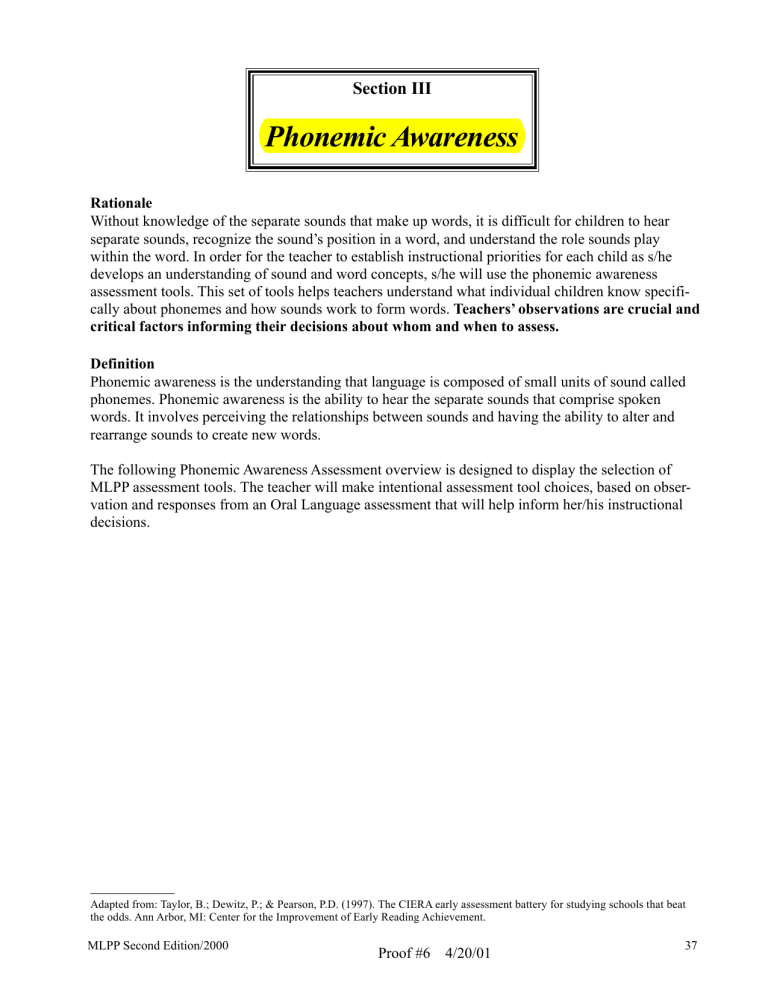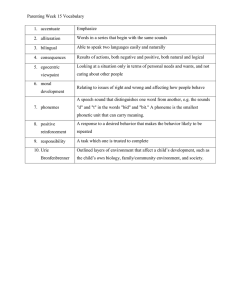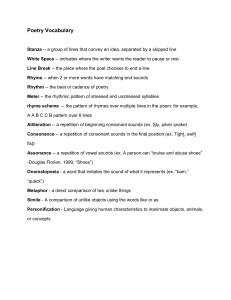
Section III Phonemic Awareness Rationale Without knowledge of the separate sounds that make up words, it is difficult for children to hear separate sounds, recognize the sound’s position in a word, and understand the role sounds play within the word. In order for the teacher to establish instructional priorities for each child as s/he develops an understanding of sound and word concepts, s/he will use the phonemic awareness assessment tools. This set of tools helps teachers understand what individual children know specifically about phonemes and how sounds work to form words. Teachers’ observations are crucial and critical factors informing their decisions about whom and when to assess. Definition Phonemic awareness is the understanding that language is composed of small units of sound called phonemes. Phonemic awareness is the ability to hear the separate sounds that comprise spoken words. It involves perceiving the relationships between sounds and having the ability to alter and rearrange sounds to create new words. The following Phonemic Awareness Assessment overview is designed to display the selection of MLPP assessment tools. The teacher will make intentional assessment tool choices, based on observation and responses from an Oral Language assessment that will help inform her/his instructional decisions. Adapted from: Taylor, B.; Dewitz, P.; & Pearson, P.D. (1997). The CIERA early assessment battery for studying schools that beat the odds. Ann Arbor, MI: Center for the Improvement of Early Reading Achievement. MLPP Second Edition/2000 Proof #6 4/20/01 37 Phonemic Awareness Overview Tool What Is Assessed Appropriate Use Rhyme Choice Phonemic awareness through auditory recognition of phoneme changes to generate a similar “rhyming” word. With a child who does not distinguish similarities and/or differences in words through auditory cues. Since the recognition of similarities and differences occur first, this assessment should be given first. Rhyme Supply A child’s ability to generate a word that rhymes with an auditory prompt. With a child who recognizes a rhyme, but needs direct instruction to generate words that rhyme. Onset and Rime Blending Awareness of phoneme patterns which reoccur in words and how to isolate the onset. With a child developing an understanding of phoneme patterns. Phoneme Blending Awareness of individual phonemes, and awareness of ways to create word patterns with phonemes. When a child demonstrates understanding of individual letter sounds, but is unable to recognize known words when blending individual sounds into words. Phoneme Segmentation Awareness of individual phonemes and the auditory position of phonemes in a word. When a child demonstrates an awareness of multiple sounds within a word. *Onset and rime are linguistic terms. Onsets are speech sounds (/b/. /j/) that appear before a vowel. A rime begins with the vowel and includes the letters that follow. If a word begins with a vowel, it only has a rime. By combining onsets and rimes (b/ ack, j/ ack) words are formed. Assessment Guidelines A quiet environment is important for this assessment in order to provide the student and teacher with the best opportunity to “hear” the prompts and responses. Specific procedures are provided in each subsection of the Phonemic Awareness assessment. Analysis MLPP Second Edition/2000 Proof #6 4/20/01 38 Phonemic Awareness Rhyme Rationale Rhyming words are words with endings which sound alike. This assessment is basically administered and responded to as an auditory assessment. A purpose in understanding rhyme is the knowledge it provides children for generating new words from a known word; for example, if you know the word “fun,” then you can make the word “run.” It is more difficult for a child to produce a rhyme than to identify a rhyme when presented. Two levels which are assessed in this Rhyme Assessment are rhyme choice and rhyme supply. In order to establish instructional priorities with the concept of rhyme for each child in the early stages of literacy development, two separate assessment tools are available. Information from these assessments helps teachers understand what individual children know specifically about rhyme. Teachers’ observations are crucial and critical relative to informing their decisions about whom and when to assess. Procedure for Rhyme Choice 1. Say to the child: When words rhyme, they sound the same at the end; for example, like, bike rhyme. Like, toy do not rhyme. Dark, park rhyme. Dark, dog do not rhyme. 2. Say to the child: I am going to say two words, and I want you to tell me if they rhyme. 3. Let’s practice. Listen to these words. Do they rhyme? cap, tap; Pause and allow student to respond. play, nap; Pause and allow student to respond. luck, buck 4. Indicate correct responses with a check (√). Record incorrect or no responses with a dot (•). 5. Discontinue testing if the child misses three consecutive items after the practice items, or if the child appears confused or frustrated. 6. Determine the child’s level of accuracy by totaling the number of correct responses and recording the score on the child’s reporting form. MLPP Second Edition/2000 Proof #6 4/20/01 39 Procedure for Rhyme Supply 1. Say to the child: When words rhyme, they sound the same at the end; for example, day, say, rhyme. 2. Say to the child: I am going to say two words, and I want you to give me a word that rhymes. 3. First let’s practice. • Listen to the words - dig, pig. Tell me a word that rhymes with dig, pig. • Tell me a word that rhymes with dark, park. • Tell me a word that rhymes with boy, joy. 4. Accept nonsense words if they rhyme. 5. Indicate correct responses with a check (√). Record incorrect responses next to the words on the child’s reporting form. Write (•) if the child cannot or will not produce a response. 6. Discontinue testing if the child misses three consecutive items after the practice items or if the child appears confused or frustrated. 7. Determine the child’s level of accuracy by totaling the number of correct responses and recording the score on the child’s reporting form. MLPP Second Edition/2000 Proof #6 4/20/01 40 Phonemic Awareness Assessment - Individual Record Student __________________________________ Grade _________ Date _______________ RHYME CHOICE Tell me if these words rhyme: 1. sit 2. fit _______ 5. truck sing _______ ball wall _______ 6. tie _______ 3. trip sock _______ 7. play day _______ 4. can pan 8. down clock _______ _______ van RHYME SUPPLY Tell me a word that rhymes with ________ 1. bat hat _______ 5. rug bug _______ 2. head bed _______ 6. be me _______ 3. fun run _______ 7. take make _______ 4. got _______ 8. mill will _______ hot Recording: Indicate correct responses with a check (√). If the child gives an incorrect word, write that word. Write • if the child cannot or will not produce a response. Discontinue: Discontinue testing if the child misses three consecutive items after the practice items or if the child appears confused or frustrated. Total number correct (16 possible) MLPP Second Edition/2000 Choice Supply Proof #6 4/20/01 41 Phonemic Awareness Phoneme Blending Rationale Children need to be able to scan through words and sequence the sounds made by letters or groups of letters. Phoneme blending is a skill to help students connect sounds in words they see but do not know; for example, if a child sees the word “met,” s/he needs to be able to isolate the sounds “/m/ pause /e/ pause /t/” in sequence, and yet be able to blend them to “hear” (auditory recognition) the word. While good instruction does not present sounds in isolation, for assessment purposes the teacher will isolate these sounds or sound groups. In order to establish instructional priorities for each child as they build an understanding of letters and sounds, the teacher will use the Phoneme Blending assessment. This assessment helps teachers understand what children specifically know about blending phonemes. Teachers’ observations are crucial and critical to informing their decisions about whom and when to assess. Procedure for Onset and Rime 1. Say to the child: Words are made by putting sounds together. I am going to say the sounds, and I want you to tell me the word they make; for example, the sounds /s/ /at/ make the word “sat.” What word would I have if I put together the sounds /m/ /et/? Pause and let student respond. (met) Practice Items What word would I have if I put together the sounds /f/ /ed/? (fed) What word would I have if I put together the sounds /m/ /ap/? (map) What word would I have if I put together the sounds /l/ /ost/? (lost) 2. Indicate correct responses with a check (√). Record incorrect responses next to the word on the child’s reporting form. If the child gives only a sound, write the letter that sound represents between two slash marks; for example, /r/. Write (•) if the child cannot or will not give a response. 3. Discontinue testing if the child misses three consecutive items after the practice items or if the child appears confused or frustrated. 4. Determine the child’s level of accuracy by totaling the number of correct responses and recording the score on the child’s reporting form. MLPP Second Edition/2000 Proof #6 4/20/01 42 Procedure for Phoneme Blending 1. Say to the child: Words are made by putting sounds together. I am going to say the sounds and I want you to tell me the word they make; for example: The sounds /p/ “pause” /o/ “pause” /t/ “pause” make the word “pot.” What word would I have if I put together the sounds /m/ ”pause” /e/”pause” /t/? (met) Practice Items What word would I have if I put together the sounds /f/ “pause” /e/ “pause” /d/? (fed) What word would I have if I put together the sounds /m/ “pause” /a/ “pause” /p/? (map) What word would I have if I put together the sounds /l/ “pause” /o/ “pause” /s/ “pause” /t/? (lost) 2. Indicate correct responses with a check (√). Record incorrect responses next to the word on the child’s reporting form. If the child gives only a sound, write the letter that sound represents between two slash marks; for example, /r/. Write (•) if the child cannot or will not give a response. 3. Discontinue testing if the child misses three consecutive items after the practice items or if the child appears confused or frustrated. 4. Determine the child’s level of accuracy by totaling the number of correct responses and recording the score on the child’s reporting form. MLPP Second Edition/2000 Proof #6 4/20/01 43 Phonemic Awareness Assessment - Individual Record Student __________________________________ Grade _________ Date _______________ ONSET AND RIME What word would I have if I put together these sounds? 1. /t/ /ake/ _______ 5. /d/ /ust/ _______ 2. /p/ /in/ _______ 6. /j/ /ump/ _______ 3. /d/ /og/ _______ 7. /m/ /ouse/ _______ 4. /t/ /ea/ _______ 8. /sl/ /eep/ _______ PHONEME BLENDING (Provide no additional help from this point.) What word would I have if I put together: 1. /t/ /a/ /p/ (tap) ________ 5. /l/ /i/ /d/ (lid) ________ 2. /p/ /e/ /n/ (pen) ________ 6. /b/ /i/ /k/ (bike) ________ 3. /j/ /o/ /g/ (jog) ________ 7. /w/ /a/ /v/ (wave) ________ 4. /c/ /u/ /t/ (cut) ________ 8. /s/ /o/ /f/ /t/ (soft) ________ Recording: Indicate correct responses with a check (√). If the child gives an incorrect response, write that response. If the child gives only a sound, write the letter that sound represents between two slash marks; for example, /r/. Write (•) if the child cannot or will not give a response. Discontinue: Discontinue testing if the child misses three consecutive items or appears confused or frustrated. Total number correct_________ (16 possible) MLPP Second Edition/2000 Proof #6 4/20/01 44 Phonemic Awareness Phoneme Segmentation Rationale In order to connect oral language knowledge to written text, children must become aware of the individual sounds that make up words. The next step is to begin to sequence the sounds from their oral language in order to reproduce that sequence with written letters to form conventional words. Children generally recognize and connect letters with the initial consonant sounds of a word first. Then children become aware of the ending consonant sounds in the word. The most difficult sound placement for a child to identify consistently is the medial letter position in a word. The purpose of this section is to assess whether children can hear and identify beginning, middle, and ending sounds in words. In order to establish instructional priorities for each child as s/he connects sounds to words, the teacher will use the sound segmentation tool. This assessment helps teachers understand what individual children know specifically about sound segmentation. Teachers’ observations are crucial and critical factors informing their decisions about whom and when to assess. Procedure 1. Say to the child: Say the word sat. You need to think about how many sounds you hear in the word sat. What is the sound you hear first? /s/. The sound you hear next? /a/. The sound you hear last? /t/. Practice Items Say the word mud. What are the sounds you hear in mud? What is the sound you hear first? /m/. The sound you hear next? /u/. The sound you hear last? /d/. Say the word not. Think about the first sound, the next sound, and the last sound. What is the sound you hear first? /n/. The sound you hear next? /o/. The sound you hear last? /t/. Say the word coat. Think about the first sound, the next sound, and the last sound. What is the sound you hear first? /c/. The sound you hear next? /o/. The sound you hear last? /t/. 2. Indicate correct responses with a check (√). Record incorrect responses next to the word on the child’s reporting form. If the child gives only one sound, write the letter that sound represents between two slash marks; for example: /r/. Write (•) if the child cannot or does not give a response. 3. Discontinue testing if the child misses 3 consecutive items after the practice items or appears confused or frustrated. 4. Determine the child’s level of accuracy by totaling the number of correct responses and recording the score on the child’s reporting form. Three checks per item equal one point. The total equals 8 points. MLPP Second Edition/2000 Proof #6 4/20/01 45 Phonemic Awareness Assessment - Individual Record Student __________________________________ Grade _________ Date _______________ PHONEME SEGMENTATION Assessment Items (Provide no additional help from this point.) What is the sound you hear first? The sound you hear next? The sound you hear last? 1. pat ( /p/ /a/ /t/ ) ________ 5. sock ( /s/ /o/ /k/ ) ________ 2. lip ( /l/ /i/ /p/ ) ________ 6. mean ( /m/ /e/ /n/ ) ______ 3. red ( /r/ /e/ /d/ ) ________ 7. joke ( /j/ /o/ /k/ ) ________ 4. tub ( /t/ /u/ /b/ ) ________ 8. fight (/f/ /i/ /t/) ________ Recording: Indicate correct responses with a check (√). If the child gives an incorrect response, write that response. If the child gives only a sound, write the letter that sound represents between two slash marks; for example, /r/. Write (•) if the child cannot or does not give a response. Discontinue: Discontinue testing if the child misses 3 consecutive items or appears confused or frustrated. Total number correct ___________ (8 possible) MLPP Second Edition/2000 Proof #6 4/20/01 46







